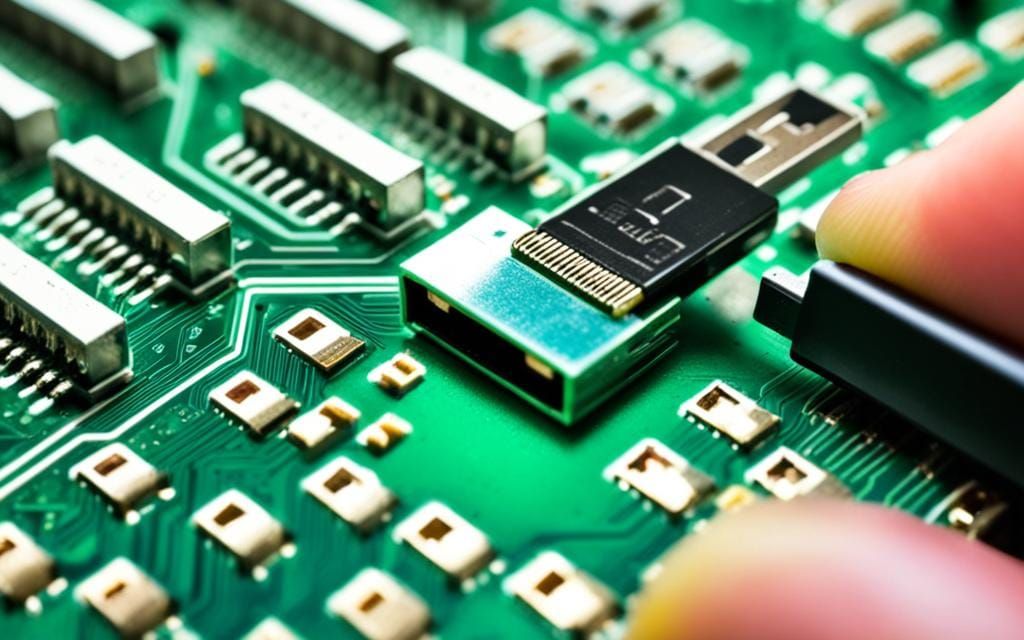In today’s digital world, keeping your PC’s drivers current is vital. It boosts performance and keeps your computer secure. Your motherboard is like your computer’s heart. It needs to run smoothly for your whole system to work well. This guide will show you the key steps to updating your motherboard drivers. By doing this, you can make sure your hardware runs at its full potential while protecting your digital life.
Motherboard drivers are like translators. They help your computer’s different parts talk to the operating system. Keeping these drivers updated offers many benefits, such as faster performance and better security. It doesn’t matter if you’re a tech pro or just use your computer for fun. Knowing why updates are key helps keep your PC in top shape.
Table of Contents
ToggleIntroduction to Motherboard Drivers
Motherboard drivers are key software that lets our computer’s operating system talk to hardware connected to the board. They’re like a bridge, making sure the software and actual parts of our computer can work together properly. Without them, our hardware might not work as it should, causing issues and poor performance.
What Are Motherboard Drivers?
Motherboard drivers are programs that help our computer’s OS understand and use the hardware parts plugged into it. This includes things like the chipset, USB ports, sound system, and the graphic or processing units.
Why Updating Motherboard Drivers is Crucial
It’s really important to keep motherboard drivers up-to-date. This stops our hardware and software from having problems working together. If drivers are old or wrong, we could see things like system crashes or security dangers. Newer drivers can also make our computer run better by fixing issues, boosting performance, and supporting the latest tech.
Updating drivers also keeps our computer safe. It’s one way to protect against cyber attacks and other threats. By always having the latest drivers, our computer can be its best in terms of speed, reliability, and safety.
Signs That You Need to Update Motherboard Drivers
The motherboard is like a computer’s spine, needing new drivers often. This keeps it working well and fitting with other parts. Wondering when to update it? We’ll go over clear signs showing it’s time.
Does your computer crash a lot or show blue screens? These big signs of outdated drivers make your PC unreliable and unstable.
If things like your mouse, keyboard, or sound don’t work right, it’s a red flag. This may come from old drivers that can’t talk to these items correctly.
Is your computer slower, taking forever to load stuff? This might mean your drivers are behind.
Watch out for weird errors or messages. They signal your motherboard is not syncing well with other parts. Updating drivers often fixes this.
Dealing with these signs of outdated drivers helps your PC’s performance and keeps PC problems away. It’s a good way to prevent stress later on.
Types of Essential Motherboard Drivers
It’s key to update your motherboard drivers for smooth use. Essential ones include chipset, USB, audio/sound, and VGA/APU drivers.
Chipset Drivers
Chipset drivers help your motherboard work with parts like the CPU and RAM. They need to stay current for your system to be stable.
USB Drivers
USB drivers make sure your USB ports work well. They help connect devices like mice, keyboards, and storage drives. Keeping them updated avoids device issues.
Audio/Sound Drivers
These drivers link your system and audio devices. They help improve sound and fix any audio problems you’re having.
VGA/APU Drivers
VGA/APU drivers connect your motherboard to display devices. Updating them improves visuals, avoids display problems, and keeps your system ready for new tech.
Knowing and updating these drivers lets your system reach its potential. It boosts performance and makes your computer use better all-around.
how to update motherboard drivers
Keeping your motherboard drivers updated is key to maximum performance and stability. First, you need to know your motherboard model. Go to the manufacturer’s website to get the right drivers.
Finding Your Motherboard Model
Finding your motherboard’s model number is easy. Here’s what to do:
- Open System Information: Press Windows key + R, type “msinfo32,” and hit Enter.
- In the new window, look for “Baseboard Manufacturer” and “Baseboard Product.” This info shows your motherboard’s make and model.
- You can also find the model on the motherboard itself or in your computer’s documentation.
Downloading Drivers from Manufacturer’s Website
Now, visit the manufacturer’s site and find the downloads page. Follow these steps there:
- Head to the manufacturer’s website and find the support or downloads section.
- Either search for your motherboard model or use the site’s search bar to locate it.
- Download the latest essential drivers like chipset, USB, audio, and video drivers.
- Then, install them as per the manufacturer’s instructions.
By doing this, you can keep your motherboard drivers current. Running your computer with updated drivers is important for a healthy and smooth experience.
Using Windows Update for Driver Updates
Using Windows Update is a great choice for keeping your motherboard drivers current. It’s a part of the Windows system that looks for important updates, like motherboard drivers, and installs them for you.
To find driver updates on Windows Update, head to your computer’s settings. Look for the “Optional updates” area. Here, you can pick which updates to install, from your motherboard’s chipset to its sound and USB features.
- Open the Windows Settings app and navigate to the “Update & Security” section.
- Click on the “Windows Update” tab and then select “View optional updates.”
- Expand the “Driver updates” section to see the available updates for your system.
- Select the updates you want to install and click the “Download and install” button.
Remember, Windows Update might not have the absolute latest motherboard driver updates. That’s why it’s smart to also visit your motherboard’s manufacturer website. This way, you can make sure you’re getting the newest updates.
By checking both Windows Update and the manufacturer’s website, you keep your drivers fresh. This helps keep your system running smoothly and without problems.
Utilizing Driver Update Utilities
Manually downloading drivers from a website or via Windows Update can be time-consuming and tricky. But, there’s a simpler way – using driver update utilities. These are tools that can ease the process of updating your drivers. They do this by handling many tasks for you.
Driver update utilities like Driver Easy, Driver Booster, and DriverMax are known for making driver updates easy. They check your system for outdated or missing drivers. Then, they update them for you. This saves you time and makes sure your computer uses the latest drivers.
Popular Driver Update Tools
- Driver Easy: It’s straightforward. It checks for outdated drivers and updates them with a single click. You can even get a premium version for extra features.
- Driver Booster: It has a vast database of drivers. It quickly finds and updates any old drivers on your PC. Plus, it helps with managing drivers and optimizing your system.
- DriverMax: This tool automatically finds and installs the newest drivers for your hardware. It also supports features like backing up your drivers and rolling them back if needed.
Using driver update utilities can make updating motherboard drivers and other components easier. Keeping your drivers current isn’t just about performance. It’s also key to computer safety and stability.

Troubleshooting Driver Installation Issues
Running into trouble while installing drivers can be frustrating. Things like compatibility problems or system crashes are common. But, there’s no need to worry. Many steps can help you fix these issues.
Start by making sure you’re downloading the right drivers for your motherboard. If you use the wrong ones, it can create more problems. This might even make your system very unstable.
If the right drivers don’t fix the problem, going back to an older driver could help. Besides, system restore can also work well. It undoes changes that might mess with your new driver, possibly solving the problem.
Checking for other software or hardware issues is wise if trouble continues. This step looks for any other devices or software that might be affecting your drivers. Solving these can often make the installation smooth again.
Remember, fixing driver problems is best done step by step. By doing things calmly and in order, you can make things work.Troubleshooting driver installation is like solving a puzzle. Get it right, and your motherboard will run smoothly with compatible drivers.
If problems persist, you can always ask for help. The manufacturer’s support team or online forums and communities can offer advice. With some effort, you can make everything work well again. This will let you enjoy the benefits of up-to-date motherboard drivers.
Best Practices for Keeping Drivers Up-to-Date
It’s important to keep your motherboard drivers updated. This helps your system work well and stay secure. If you follow a few tips, you can easily keep your drivers current and your computer running smoothly.
Regular Manufacturer Website Checks
Visit the manufacturer’s website often to get the latest drivers. They update drivers to fix bugs, make things work better together, and add new features. Set a reminder to check for updates every few months.
Enabling Automatic Windows Updates
Having Windows Update your drivers automatically can be handy for some. With this, your system will always have the newest drivers from Microsoft. Just remember to look at the updates first to check for issues.
Using Driver Update Utilities
Driver update tools like Device Manager or others make finding and installing new drivers easy. These tools check your system, find old drivers, and show you how to update them. Make sure you pick trusted update tools to stay safe.
| Best Practice | Description |
|---|---|
| Regular Manufacturer Website Checks | Visit the motherboard manufacturer’s website every few months to check for the latest driver updates. |
| Enabling Automatic Windows Updates | Allow Windows Update to handle driver updates for a hands-off approach, but review the updates before installation. |
| Using Driver Update Utilities | Utilize reputable driver update tools to simplify the process of identifying and installing the latest drivers. |
With these practices, you’ll keep your system safe, stable, and at its best. Remember, regularly updating drivers unlocks your motherboard’s full potential and makes your computer experience better.
Benefits of Updating Motherboard Drivers Regularly
Keeping your motherboard drivers updated has many benefits of updating motherboard drivers. It can make your PC faster and work better by fixing compatibility problems. Also, it adds security updates, making your PC less open to hacks and enhance PC security.
Improved System Performance
Updating your motherboard drivers helps everything in your PC work together smoothly. Old drivers might not match new software, causing your PC to be slow or crash. By adding new ourdates, your PC can perform much better.
Enhanced Security
Every computer user should worry about safety online. Regular updates include fixes to stop bad people from getting into your computer. This keeps your private info safe from malicious actors.
| Benefit | Description |
|---|---|
| Improved System Performance | Fixing issues so your system runs better and faster. |
| Enhanced Security | Defending against potential attacks with updated fixes. |
Choose to frequently update your motherboard drivers. You’ll see your PC become more powerful and secure. Updating is easy and keeps your computer at its peak.
Conclusion
We’ve gone through the key steps to update your motherboard drivers. We covered why it’s essential to update, how to spot when they need an update, and ways to do it. Now, you have what you need to make your PC perform better and stay secure.
Keeping your drivers up-to-date is vital for a good and safe computer. Updated drivers can make your system work better and keep it secure. This guide shows you how to take care of your motherboard drivers. It helps you have a smooth computer experience.
The most important points are to always update your motherboard drivers, know the ways to update them, and understand the benefits. Updating drivers is crucial for your system’s full potential and data protection. With this information, you can ensure your system runs well and stays safe.
FAQ
What are motherboard drivers?
Motherboard drivers help your computer talk to its hardware. They are important for everything to work right.
Why is updating motherboard drivers crucial?
Updating your drivers is key for smooth operation. It prevents problems, makes your system faster, and keeps it safe.
What are the common signs that my motherboard drivers need an update?
If you see your computer crashing often or devices not working, it might be the drivers. Slow performance and odd error messages are red flags too.
What are the essential motherboard drivers I need to update?
Key drivers to update are the chipset, USB, audio/sound, and VGA/APU.
How do I update my motherboard drivers?
First, find your motherboard model. Then, go the manufacturer’s site and get the latest drivers. Install them to update.
Can I use Windows Update to update my motherboard drivers?
Using Windows Update is good, but it’s best to get drivers directly from the manufacturer. This ensures you get the latest versions.
What driver update utilities can I use to simplify the process?
Tools like Driver Easy, Driver Booster, and DriverMax can help. They find old drivers and update them easily.
What should I do if I encounter issues during the driver installation process?
Make sure you’re downloading the right drivers. If issues remain, try going back to a previous driver or a system restore.
What are some best practices for keeping my motherboard drivers up-to-date?
Check for updates on the manufacturer’s site regularly. Turn on automatic Windows Updates. Consider using driver utilities. These steps can make updating easier.
What are the benefits of updating my motherboard drivers regularly?
Updating keeps your system working well. It fixes issues, speeds up performance, and makes your computer safer.
















